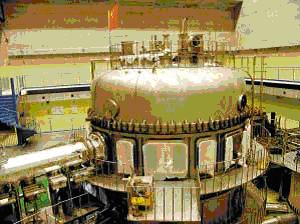After an exploratory phase with different magnetic confinement configurations, the magnetic fusion development in China has evolved to focus on the tokamak concept. Presently, the tokamaks in China include:
· HT-7 is a medium sized super-conducting tokamak in Institute of Plasma Physics, Chinese Academy of Sciences (ASIPP) in Hefei. Its main purpose is to explore high performance plasma operation under steady-state condition. Recently, it was also devoted to the study of the turbulence structures in the plasma edge and their propagation across magnetic surfaces. Another small tokamak HT-6M in ASIPP is used to study ICRF and transport.
· The South Western Institute of Physics (SWIP) in Chengdu has medium sized HL-1M tokamak, in which plasma heating and advanced fueling are investigated. The HL-2A is a divertor tokamak for exploring divertor related topics and also topics related to ITER.
· Other two small tokamaks in China are KT-5C in the University of Sciences and Technology of China (USTC) in Hefei and CT-6B in the Institute of Physics, Chinese Academy of Sciences (IP/CAS). They are operated for edge turbulence/transport study and alternative concept development.
One of the latest tokamak is the EAST (Experimental Advanced Superconducting Tokamak). It is a mega-ampere full superconducting tokamak aiming at steady-state operation with the shaped plasma cross-section. It is an improvement over the earlier superconducting tokamak device, HT-7. Steady-state plasmas will be sustained by intensive use of radio frequency heating and current drive. The physics and technologies of long pulse operation with non-inductive current drive are essential basis for EAST.
EAST is also located in in ASIPP in Hefei. Construction was completed in March 2006 and on September 28, 2006, "first plasma" was achieved. In February 2007 the reactor sustained an electrical current of 250 kA for five seconds.

Source: http://news.sina.com/ch/phoenixtv/102-101-101-102/2008-01-22/14292618428.html